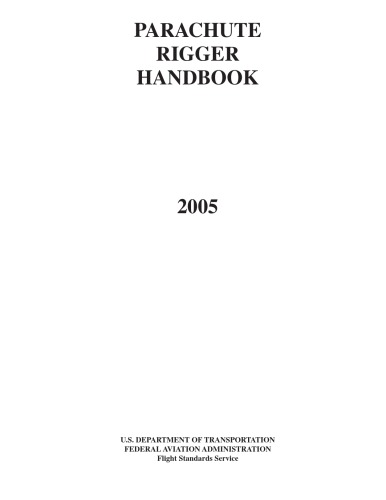

Most ebook files are in PDF format, so you can easily read them using various software such as Foxit Reader or directly on the Google Chrome browser.
Some ebook files are released by publishers in other formats such as .awz, .mobi, .epub, .fb2, etc. You may need to install specific software to read these formats on mobile/PC, such as Calibre.
Please read the tutorial at this link: https://ebookbell.com/faq
We offer FREE conversion to the popular formats you request; however, this may take some time. Therefore, right after payment, please email us, and we will try to provide the service as quickly as possible.
For some exceptional file formats or broken links (if any), please refrain from opening any disputes. Instead, email us first, and we will try to assist within a maximum of 6 hours.
EbookBell Team

4.3
98 reviews
ISBN 10: 1601707967
ISBN 13: 9781601707963
Author: Federal Aviation Administration
Chapter 1 – Introduction to Parachute Rigging
Regulations and Human Factors
Parachute Rigger Certificates
Eligibility and Requirements
Testing
Alternate Means of Qualifying for a Parachute Rigger Certificate
Retesting
Responsibilities of a Certificated Parachute Rigger
Facilities and Tools
Performance Standards
Currency Requirements
Record Keeping
Sealing the Parachute
Regulatory Compliance
“14 CFR Part …” etc (Definitions, TSOs, ADs)
Rigging Ethics
Pilot Versus Parachute Size
Parachute Service Life
Chapter Summary
Chapter 2 – Design and Construction
Introduction
Parachute Design and Construction
Component Parts (Main Canopy, Reserve Canopy, Emergency Canopy, Harness/Container, etc)
Deployment Devices
Main Parachute Release Mechanism and Associated Handles or Static Lines
Risers and Steering Toggles
TSO Standards
Canopy Design & Nomenclature
Construction Concepts and Techniques
Operational Theory
Materials, Damage, Containers, Harness Design
Bridles and Deployment Devices
Different Deployment Types
Bridles & Pilot Chutes
Automatic Activation Devices (AADs) & Reserve Static Lines (RSLs)
Main Riser Attachment, Ripcord Cable Routing, RSL Lanyard and Container Mount, etc
Joint Efficiency
Chapter Summary
Chapter 3 – Materials
Introduction
Specifications
Fabrics
Webbing and Tapes
Webbing Selection
Cords, Lines, Threads
Hardware
Plastics and Synthetics
Fasteners
Housings
Ripcords, Cables and Swages
Miscellaneous Materials
Chapter Summary
Chapter 4 – Operations
Introduction
Sport Parachute Main Packing Techniques
Deployment and Inflation Characteristics
Main Pilot Chute
Bridle Length
Rubber Bands
Assembly of Main Canopy to Harness & Container
Assembly of Components and Compatibility
Reserve Bag Extraction Force
TSO Certification & Placard Limitations
Harness Strength
Volume
Deployment Type
Chapter Summary
Chapter 5 – Inspection and Packing
Introduction
Identification
Inspection
Component Compatibility
Round Canopies and Pilot Emergency Systems
Straightening the Canopy
Damage Identification
Pilot Chute and Bridle
Reserve Canopy
Suspension Lines and Connector Links
Harness
Container
Ripcord
Airing and Drying
Ram-Air Reserves and Sport Piggyback Systems
Canopy Assembly and Line Continuity
Inspection (Harness, Container, Ripcord)
Rigging and Repairs
Packing (Round Canopy into Pilot Emergency, Ram-Air Reserve into System, etc)
Documentation
Chapter Summary
Chapter 6 – Hand Tools, Sewing Machines, and The Parachute Loft
Introduction
Hand Tools (description, identification, uses, control, maintenance)
Sewing Machines (identification, theory, needles, operation, attachments)
The Parachute Loft (packing and inspection area, layout tables, sewing machines, work & storage areas)
Chapter Summary
Chapter 7 – Repairs, Alterations, and Manufacture
Introduction
Inspection Process
Major or Minor Repairs
Contamination Conditions (acid, etc)
Repair Techniques (canopy, lines, container, harness, risers, hardware)
Manufacturing (closing loops, stitc
faa parachute rigger handbook
parachute rigger handbook pdf
parachute rigger handbook pdf free download
parachute rigger jobs
parachute rigger salary
what is a parachute rigger